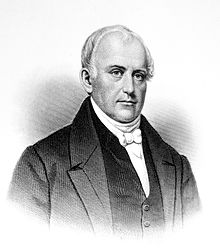Industrial Revolution in the United States
The Industrial Revolution involved a shift in the United States from manual labor-based industry to more technical and machine-based manufacturing which greatly increased the overall production and economic growth of the United States, signifying a shift from an agrarian to an industrial economy widely accepted to have been a result of Samuel Slater's introduction of British Industrial methods in textile manufacturing to the United States,[1] and necessitated by the War of 1812.[2]

Samuel Slater - "Father of the American Industrial Revolution"
Contents
1 Origins
2 Effects of the First Industrial Revolution
3 See also
4 References
Origins
As Western Europe began industrializing in the late 1700s and early 1800s, the United States remained agrarian in nature with resource processing, such as gristmills and sawmills being its major semi-industrial pursuit,[3] however, as demand for U.S. resources increased, canals and railroads became extremely important to economic growth due to sparse population[4] particularly in areas where resources were rich such as in the Western frontier. This made it necessary for the U.S. to expand its technological capabilities, which led to an Industrial Revolution reaching American shores as entrepreneurs competed and learned from each other to develop better technology, fundamentally and permanently altering the U.S. economy, thrusting it into the new age of industrialization.
The "Father of the American Industrial Revolution",[5] Samuel Slater, was born in Belper, Derbyshire, England on June 9, 1768, and began working at a cotton mill from age 10. He learned that Americans were interested in the Industrial Revolution's new techniques, but since exporting such designs were illegal in England, he memorized as much as he could and departed for New York in 1789 illegally. Moses Brown, a leading Rhode Island industrialist, attempted to operate a mill with a 32-spindle frame in Pawtucket, but he couldn't. It was at that time that Slater offered his services, promising to replicate British designs for Brown and, after an initial investment by Brown to Slater to fulfill initial requirements, the mill successfully opened in 1793 being the first water-powered roller spinning textile mill in the Americas. By 1800, Slater's mill had been duplicated by many other entrepreneurs as Slater grew wealthier and his techniques more and more popular, which brought him the name "Father of the American Industrial Revolution" by Andrew Jackson in the U.S., but also the name "Slater the Traitor" by many in Great Britain who felt he betrayed them to the Americans.[6]
Effects of the First Industrial Revolution
The Industrial Revolution permanently altered the U.S. economy and set the stage for the United States to dominate technological change and growth in the Second Industrial Revolution[7] in its Gilded Age. The American System (economic plan) gave way to new economic thought such as the classical school of economics which assisted in the growth of trade and commerce, but this time with the U.S. as a much larger exporter than importer, which would continue until the late Cold War era with the drastic increase in imports from China. The Industrial Revolution also saw a decrease in the rampancy of labor shortages which characterized the U.S. economy in the late 18th and early 19th centuries.[8] This was because there was a "transportation revolution" that happened in the same period, which was massively important due to the sheer size and low population density of the U.S. at the time, connecting population centers such as through the Wilderness Road and the Erie Canal, coupled with the development of Steamboats and Rail transport, allowing for the phenomenon of urbanization to begin which increased the labor force available around larger cities such as New York City and Chicago, ameliorating the classic American labor shortages of the time. This also allowed for the quicker movement of resources and goods around the country, drastically increasing trade efficiency and output, while allowing for an extensive transport base for the U.S. to grow from in the Second Industrial Revolution.[9]
See also
- List of mill towns in Massachusetts
References
^ "The Industrial Revolution in the United States - Primary Source Set | Teacher Resources - Library of Congress". www.loc.gov. Retrieved 2016-05-17..mw-parser-output cite.citation{font-style:inherit}.mw-parser-output q{quotes:"""""""'""'"}.mw-parser-output code.cs1-code{color:inherit;background:inherit;border:inherit;padding:inherit}.mw-parser-output .cs1-lock-free a{background:url("//upload.wikimedia.org/wikipedia/commons/thumb/6/65/Lock-green.svg/9px-Lock-green.svg.png")no-repeat;background-position:right .1em center}.mw-parser-output .cs1-lock-limited a,.mw-parser-output .cs1-lock-registration a{background:url("//upload.wikimedia.org/wikipedia/commons/thumb/d/d6/Lock-gray-alt-2.svg/9px-Lock-gray-alt-2.svg.png")no-repeat;background-position:right .1em center}.mw-parser-output .cs1-lock-subscription a{background:url("//upload.wikimedia.org/wikipedia/commons/thumb/a/aa/Lock-red-alt-2.svg/9px-Lock-red-alt-2.svg.png")no-repeat;background-position:right .1em center}.mw-parser-output .cs1-subscription,.mw-parser-output .cs1-registration{color:#555}.mw-parser-output .cs1-subscription span,.mw-parser-output .cs1-registration span{border-bottom:1px dotted;cursor:help}.mw-parser-output .cs1-hidden-error{display:none;font-size:100%}.mw-parser-output .cs1-visible-error{font-size:100%}.mw-parser-output .cs1-subscription,.mw-parser-output .cs1-registration,.mw-parser-output .cs1-format{font-size:95%}.mw-parser-output .cs1-kern-left,.mw-parser-output .cs1-kern-wl-left{padding-left:0.2em}.mw-parser-output .cs1-kern-right,.mw-parser-output .cs1-kern-wl-right{padding-right:0.2em}
^ "Significant Events of the American Industrial Revolution". About.com Education. Archived from the original on 2012-07-23. Retrieved 2016-05-22.
^ Taylor, George Rogers (1969). The Transportation Revolution, 1815-1860.
ISBN 978-0873321013.
^ Chandler Jr., Alfred D. (1993). The Visible Hand: The Management Revolution in American Business. Belknap Press of Harvard University Press.
ISBN 978-0674940529
^ "The First American Factories [ushistory.org]". www.ushistory.org. Retrieved 2016-05-22.
^ Heath, Neil. "Samuel Slater: American hero or British traitor?". BBC News. Retrieved 2016-05-20.
^ Vatter, Harold G.; Walker, John F.; Alperovitz, Gar (June 1995). "The onset and persistence of secular stagnation in the U.S. economy: 1910–1990, Journal of Economic Issues".
^ Habakkuk, H. J. (1962). American and British Technology in the Nineteenth Century. London, U.K., New York, USA: Cambridge University Press.
ISBN 978-0521094474
^ Eugene S. Ferguson, Oliver Evans, Inventive Genius of the American Industrial Revolution (Hagley Museum & Library, 1980).
